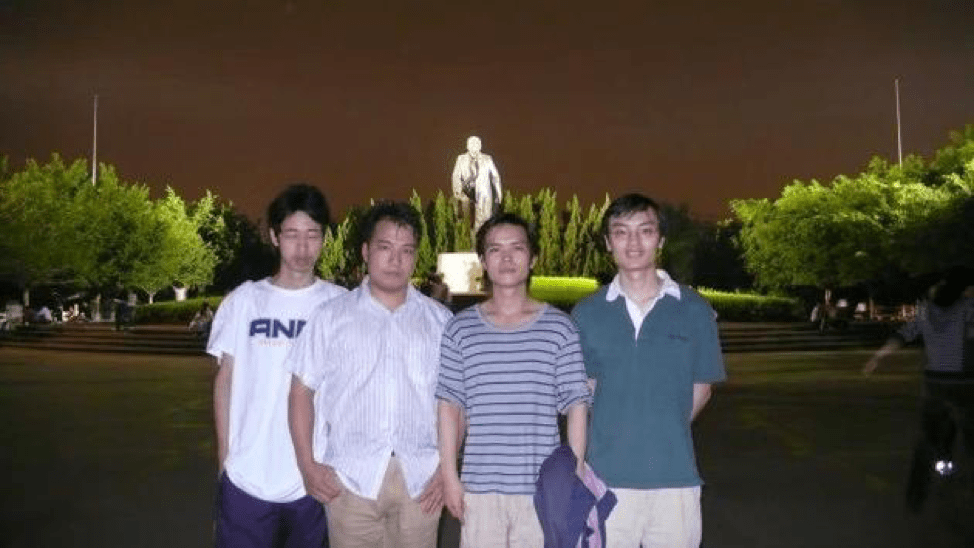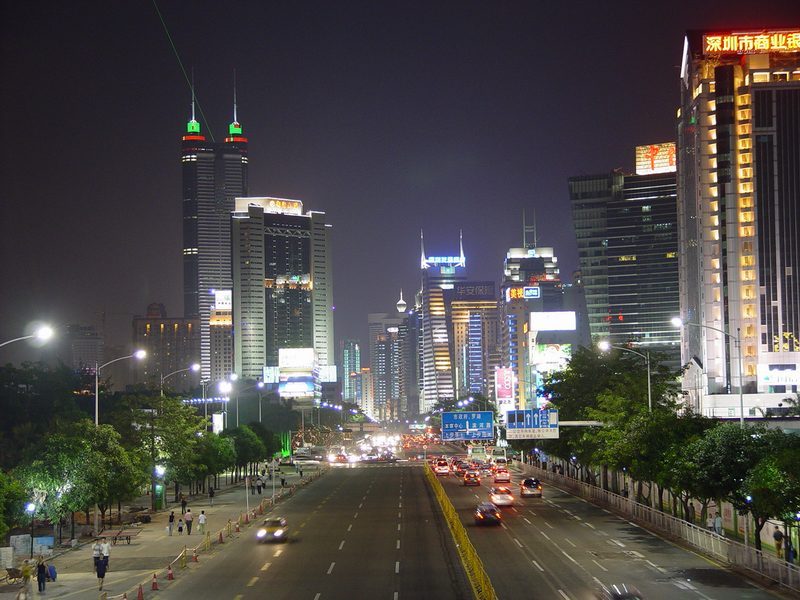
As China grows in prominence as a world leader in the manufacture of drones one city has become a drone cluster, a center of innovative drone development. On a recent trip to China, DRONELIFE pieced together some Shenzhen’s history and growth as a drone cluster city – starting with the group of friends who began recreational drone giant DJI.
The photo above, taken in Shenzhen, shows the fearless young founders of DJI, shortly after the graduates of Hong Kong University of Science started what would become the world’s highest profile drone manufacturer. The initial team, Frank Wang, Jinying Chen, Zhihui Lu and Chuqiang Chen (left to right) disbanded two years after this photo was taken; but the paths they took individually helped to form what may be the world’s most powerful drone cluster city.
Frank Wang’s story is well known: the CEO of DJI founded the company in 2006, after winning third place at RoboCon Asia-Pacific Collegiate Robot Contest the same year. The contest win led him to try to commercialize his product: he opened the first DJI office at his uncle’s magazine warehouse in Shenzhen, China.

Shenzhen is located along the Hong Kong border, and has not been a manufacturing center for long. The city was designated the first of China’s Special Economic Zones (SEZs) in 1979, when it was merely a group of farming and fishing communities along the border with a total population of a few hundred thousand. China planned to create an isolated enclave to experiment with market reforms; Shenzhen was chosen because of its proximity to Hong Kong, with its capital resources and entrepreneurial expertise.
Shenzhen is now a city of 14 million, with a population density the 5th highest in the world. It is the richest city in China, having the highest reported per capita GDP. And it is also home to more drone manufacturers and drone development offices than almost anywhere else on the globe.
Wang recruited his initial team carefully, choosing energetic young engineers who believed in the possibility of drone technology. Zhihui Lu was the youngest member of the team – when recruited to DJI he shut his own small company down and moved to Shenzhen with only 100 dollars in his pocket. Jinying Chen and Chuqiang Chen both gave up existing jobs to join the team. In a tribute to Wang’s famed ability to sell his vision, Chujiang Chen actually had to go into debt to join the company, being under a 3 year contract calling for a 30,000 RMB (about $4,600) penalty for leaving. The founders say that he earned the nick name “Thirty Thousand Chen” as he worked to pay his obligation.
While Wang was the only one with a drone background – in 2006 drone technology was not widespread and consumer drones were unknown -all had a passion for innovation. Constant experimentation and late nights fueled the development of what would become DJI’s first products, as the team worked round the clock to perfect their vision. “Frank Wang was a person that never gave up, no matter how troublesome the situation was.” Lu says.
By the end of 2008, with DJI’s first drones well under development, typical startup pressures had taken their toll on the core group of founders. Lu, Chujiang Chen and Jinying Chen all left DJI within about six months – taking their newfound technology expertise with them. Zhihui Lu moved to Aerotech, eventually bringing Chen Chujiang with him. Lu worked first on Aerotech’s consumer drone R & D team, but rapidly began to focus on infrastructure applications for the technology. Lu developed an electric inspection business model while Aerotech developed their first domestic electrical inspection drone.
Eventually, Lu presented development plans for a multi-rotor drone to the Aerotech CEO: Aerotech declined to retail the product, deciding to maintain company focus on military grade technology. Seeing the commercial applications for the mult-rotor product, Lu left Aerotech and created his own drone manufacturing company, MMC. “I knew I wanted to stay in the drone industry – the work we had done meant I could envision the future of this technology. The field seemed almost limitless, ” says Lu. While Chujiang Chen did not follow him, Jinying Chen reunited with Lu at MMC, becoming the company’s director of R & D.
Focused on the industrial market, MMC has maintained a low profile; but the company has continued to innovate in drone technology. With clients in surveying, power line inspection, and construction MMC has moved into the global market: recently releasing a hydrogen powered drone with a 4 hour flight time, MMC is poised to be a revolutionizing force in the industrial drone market as DJI has been in the consumer space.
“The drone industry is expanding so fast it is almost unbelievable – here in Shenzhen we were at the forefront, the leading edge. Shenzhen continues to be a center for this technology. It’s an exciting place to be right now,” says Lu. Shenzhen has indeed become a center for drones – started in part by the four engineers who began a decade ago with not much else but a good idea.
Miriam McNabb is the Editor-in-Chief of DRONELIFE and CEO of JobForDrones, a professional drone services marketplace, and a fascinated observer of the emerging drone industry and the regulatory environment for drones. Miriam has penned over 3,000 articles focused on the commercial drone space and is an international speaker and recognized figure in the industry. Miriam has a degree from the University of Chicago and over 20 years of experience in high tech sales and marketing for new technologies.
For drone industry consulting or writing, Email Miriam.
TWITTER:@spaldingbarker
Subscribe to DroneLife here.